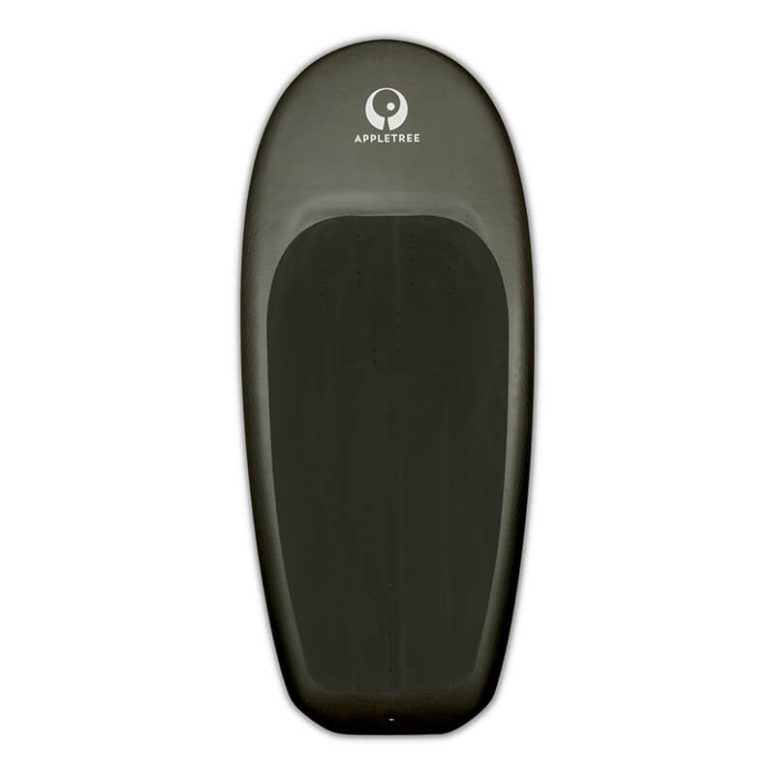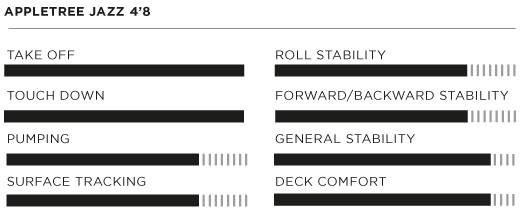

When you purchase gear through links on our site, we may earn a small commission. Here’s why you can trust our tests and our affiliate partner.

Appletree are a well established brand in the kite market, focusing their attention entirely on boards and offering a comprehensive range of custom shapes and construction, made in their own bespoke production facility in Portugal. A wingfoil-specific board range was a logical step for them. As freestyle wingfoiling has developed they’ve released the Jazz, which focuses specifically at this quickly evolving new discipline.
Our test board was supplied in matt black carbon, which really displays the level of detail and craftsmanship in the build. You can see through to the cut lap on the rail, the extra reinforcement around the foil box. It’s a very honest policy, with no paint covering the tricky bits of the lamination. If you do fancy some color and order a custom, various tail dips and a range of colored finishes are available. The construction basis is from their tried and tested 50k closed cell foam, which unlike EPS has the handy attribute of not absorbing water if you ding the board or expanding in heat. Epoxy is then vacuum infused into the carbon layup. Internally there’s more carbon wrapping and reinforced Futures track boxes, which are set into a block of PET honeycomb ensuring a super solid connection to the foil.
Shape-wise, the Jazz is very much tailored to task. It’s compact in length and the planform length has been minimized centering its swing weight for rotations. The back of the board is flat and offers a clean and fuss-free release from the surface. The top of the tail, behind the pad has a rounded chamfer which makes sliding your body on and off very comfortable.
Matching the board to your weight and conditions is important. For my 90kg frame, the 62l makes the Jazz a designated and unapologetic sinker, but due to some intelligent design decisions, it has a wider range of use than I expected. The board’s volume is biased towards the front, and sits under your knees, making a relatively low volume board exceptionally easy to waterstart even with small high-aspect foils. As soon as you have forward momentum, the board comes straight up under you and provides a stable platform to get to your feet. It has that flat skim board ability to plane, with the foil providing the tracking and directional stability pushing through chop with ease. The smoothed nose is where the bulk of the rocker is located, coupled with a slight recess in the deck where the flat 3mm EVA pad sits, leveling up the angle with the foil box. From the top it’s almost reminiscent of a foiling George Greenough spoon. That recess helps you locate your knees underwater, and there’s just enough nose for it to sit above the surface and be stable in the kneeling position to get power into the wing. Strap inserts are present in a Y configuration.
Loading up for a jump takes minimal effort, and the low swing weight initiates rotations without much effort. Landing nose heavy, we were surprised at what we could manage to ride out of. Come in with speed and it seems to skip across the water gracefully. If you do bog, if you get your weight over the front foot it stabilizes, and planes again quickly. In the surf, the low windage and swing weight really shines in terms of maneuverability. Again, that clever placement of volume under the knees means if you need to water start in between sets with time constraints, it’s doable and not that undignified.
Beautifully constructed, the Jazz strikes an excellent balance between practicality and performance, allowing you to practice freestyle without having to be incredibly powered. It provides you with a highly connected feel to the foil instantly feeling reactive and snappy, enabling you the feedback required to push your riding in both freestyle and surf. RB
